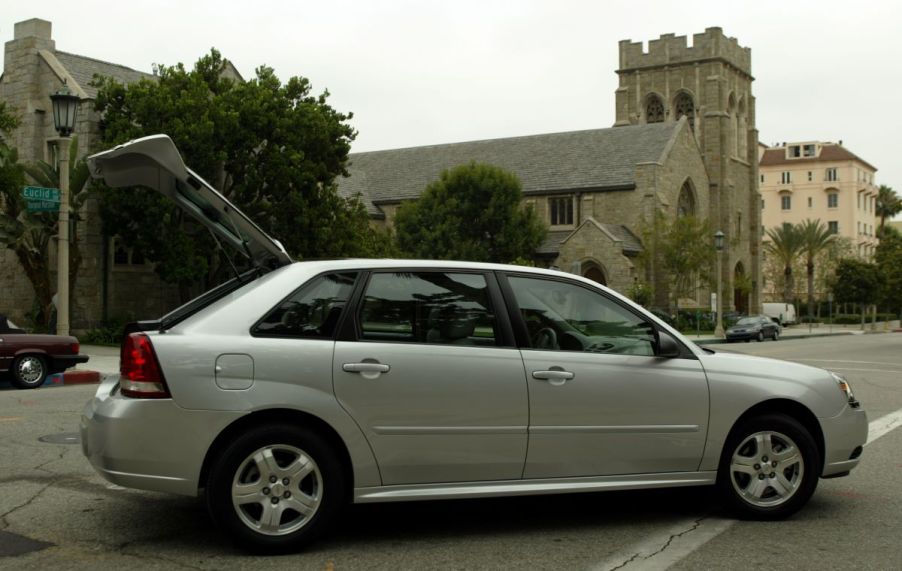
You Forgot About the Funky Five-Door Chevrolet Malibu Maxx
General Motors (GM) has helped Chevrolet pump out the Malibu since the 1960s. Although there was a decade and a half without one, it’s been one of America’s most popular sedans. But many forget about the interesting five-door variant the company made in the sixth generation. While it wasn’t as popular as its sedan sibling, the hatchback was a global car’s attempt to make it in America.
The multi-division GM core of the Chevrolet Malibu Maxx
Chevrolet’s Malibu Maxx was one of the dozen or so variants of GM’s Epsilon platform. The global architecture was the underpinning for other midsize sedans like the Buick Lacrosse, Fiat Chroma, Opel Signum, Saab 9-3, and Vauxhall Vectra. Although most were four-door sedan configurations, the Maxx was built on an extended chassis for the five-door hatchback layout.
In 2004, the Malibu Maxx debuted with a sleek, modern design with a long wheelbase and short overhangs. The front end featured a bold, chrome-accented grille and headlamps that extended into the fenders. Efforting to prove its distinctive profile, it has a low, sporty stance and a sloping roofline. At the rear, the dominatingly large liftgate revealed an ultra-spacious cargo area with 22.8 cubic feet of capacity and a 60/40 split-folding rear seating row for more.
A utilitarian, economical interior
Like most global market cars, the Malibu Maxx’s interior was styled to be innocuous. With a roomy, comfortable cabin with seating for up to five passengers, it boasted a flexible interior layout. The dashboard was simple and well-organized, with easy-to-read gauges and easy-to-use physical controls.
A base model Malibu Maxx LS came standard with a range of features, including air conditioning, power windows and locks, and a CD stereo system. The LT, LTZ, and SS added welcome amenities such as alloy wheels, a leather-wrapped steering wheel, a more powerful audio system, and even a rear seat DVD system.
What’s under the hood of the Malibu Maxx?
The Malibu Maxx was available with two different engines, both of which had substantial displacement for a midsize economy car. The base LS and the LT were stocked with a 3.5-liter V6 that produced 200 horsepower and 220 pounds-feet of torque. But if potential buyers wanted more power, an SS version could satisfy those desires.
The top-tier Maxx had a 240-horsepower 3.9-liter V6. But power still went through the traditional four-speed automatic to the front wheels only. Nevertheless, its 241 pounds-feet of torque meant it was an optimal highway cruiser, but it could still snap a speedo in a respectable seven seconds. Despite the inevitable torque steer, Edmunds asserted the Malibu Maxx was a “competent performer.”
Fuel economy was a priority for the Chevrolet Malibu Maxx, but it was geared more toward highway efficiency. The base 3.5-liter engine was rated at 22 mpg in the city and 30 mpg on the highway, while the more powerful 3.9-liter engine provided 18 mpg and 26 mpg in the respective driving conditions. A four-cylinder LS Malibu Maxx could achieve more, but it was only offered through fleet sales.
What happened to the Chevrolet Malibu Maxx?

After just four years on the market, GM canceled the Malibu Maxx. To shift its focus further on SUVs, Chevrolet ditched the hatchback but kept the four-door Malibu.
The Chevrolet Malibu Maxx was a versatile and practical car that offered a range of features and options for its buyers. Its unique hatchback design provided increased cargo capacity and interior flexibility, making it great for families. With its somewhat fuel-efficient engines and sleek styling, the Malibu Maxx was an excellent choice for anyone in the market for a practical yet slightly obscure car.


